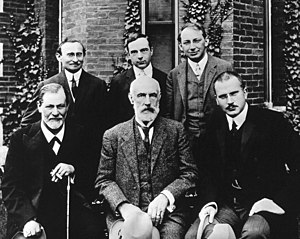Psychoanalysis
Psychoanalysis is a field of psychology and medical therapy. It is a set of theories and ways of treating mental disorders. It was started in the early 1890s by the Austrian psychologist Sigmund Freud,[1] with experience from the clinical work of Josef Breuer and others.


Since then, psychoanalysis has expanded and been revised, reformed and developed in different ways. Freud's own colleagues and students, such as Alfred Adler and Carl Jung, had their own ideas. They went on to develop their ideas independently from Freud. Much later, Anna Freud and Melanie Klein used the ideas to treat troubled children.
The basic ideas of psychoanalysis are:[2]
- besides inherited personality, a person's development is determined by events in early childhood;
- human behavior, experience, and thought is largely influenced by unconscious irrational drives;
- attempts to bring these drives into awareness is resisted by defence mechanisms;
- conflicts between conscious and unconscious (repressed) material can result in mental disturbances such as neurosis, neurotic traits, anxiety, depression, etc.;
- liberation from the effects of the unconscious material is achieved by bringing this material into the conscious mind (e.g. by the skilled guidance of the analyst.[3]
The unconscious mind
changeSometimes people cannot say why they are feeling the way they feel or acting the way they act. What causes the feelings and actions is called the unconscious mind in psychodynamic theory.
Different methods
changeUnder the broad umbrella of "psychoanalysis" there are at least 22 different approaches to the theory and clinical treatment. The term also refers to a method of studying child development.
Freudian psychoanalysis uses a type of treatment where the subject (analytic patient) talks, including free associations, fantasies, and dreams.[4] From these the analyst works out the unconscious conflicts which cause the patient's symptoms and character problems. By interpreting them for the patient, the analyst creates insight into the problems. The analyst identifies and clarifies the patient's pathological defences, wishes and guilt.
Psychoanalysis has been criticized on many fronts. It has been called a pseudoscience, and lacking in empirical support.[5][6][7][8] However, it remains influential within psychiatry, more so in some quarters than others.[9][10]
References
change- ↑ Freud S. 1940. An outline of psychoanalysis. (The standard edition of the complete psychological works of Sigmund Freud, volume XXIII)
- ↑ Freud, Sigmund 1922. Introductory lectures on psycho-analysis: a course of twenty-eight lectures delivered at eh University of Vienna. Authorised English translation by Joan Riviere with a Preface by Ernest Jones. London: Allen & Unwin.
- ↑ Erich Fromm 1992. The revision of psychoanalysis, p13/14.
- ↑ Freud, Sigmend. 1913. The interpretation of dreams. Authorised translation of third edition with introduction by A.A. Brill. London: George Allen.
- ↑ Fisher, Seymour, Greenberg Roger P. 1996. Freud scientifically reappraised: testing the theories and therapy. New York: John Wiley.
- ↑ Popper KR, "Science: conjectures and refutations", reprinted in Grim P. 1990. Philosophy of science and the occult, Albany, pp. 104–110. See also Popper's Conjectures and Refutations.
- ↑ Webster, Richard 1996. Why Freud was wrong: sin, science and psychoanalysis. London: Harper Collins.
- ↑ Gellner, Ernest, The psychoanalytic movement: the cunning of unreason, a critical view of Freudian theory. ISBN 0-8101-1370-8
- ↑ Sadock, Benjamin J. and Sadock, Virginia A. 2007. Kaplan and Sadock's Synopsis of Psychiatry. 10th ed., Lippincott Williams & Wilkins, 190.
- ↑ Michels, Robert. "Psychoanalysis and psychiatry: a changing relationship", American Mental Health Foundation.